DNA and your family history
A relatively new addition to the list of tools that genealogists have at their disposal is DNA Testing. The world of genealogical DNA can be very interesting, but also very complicated.
Which test should I take?
Where should I buy my test?
If I take a test will I instantly know my family tree?
I’ve spit into the test tube, now what?
What can I really do with the results?
Those are all common questions. I was actually asked about DNA testing three times during the last week just in the midst of normal conversations. I suppose my conversations are not always very normal since people are still trying to figure out where I’m spending my time now that I’m retired from the corporate world, but in any case, I’m being asked about DNA testing more and more often these days.
I am a genealogist and family historian but not a geneticist, so I definitely do not consider myself an expert in this subset of genealogy. But I do know some things that not everyone may know, so I thought I would write about some DNA testing basics that might be helpful. At the end of my article, I have posted links to many resources that let you dig a lot deeper. But, let’s start with some basics…
Three Types of DNA
Very basically, there are three kinds of DNA tests.
- Autosomal – can be taken by both to males and females; used to give you an idea of your ethnicity and connections to all the branches on your tree. This is the most common kind of testing and the kind that you see advertised by Ancestry in their TV commercials.
- Y-DNA – available to males only; used to give you your pure male paternal lineage. Each man gets certain DNA from his father who got it from his father who got it from his father and so on. It only passes from a father to a son. If a guy is trying to find out who is father might be, Y-DNA testing would be the most useful.
- mtDNA – available to males and females; used to give you your distant maternal lineage. It is passed by a mother to both her sons and daughters. Men get this from their mother, but do not pass it down to their offspring.
There are several companies who sell DNA testing kits. So, once you determine which type of test to take, you will be able to figure out where to make your purchase. There are a couple links later in this post that can be useful in comparing the different testing companies.
A Very Simple Autosomal DNA Example
The following may be helpful in understanding the basics of how you get your autosomal DNA.
Let’s say that each of your grandparents has four pieces of DNA (really there are thousands).
Your grandpa gives your dad two of his four and your grandma gives your dad two of her four, so that your dad ends up with four pieces of DNA. They do the same for their other son, your uncle. But your dad and your uncle get a different set of things.
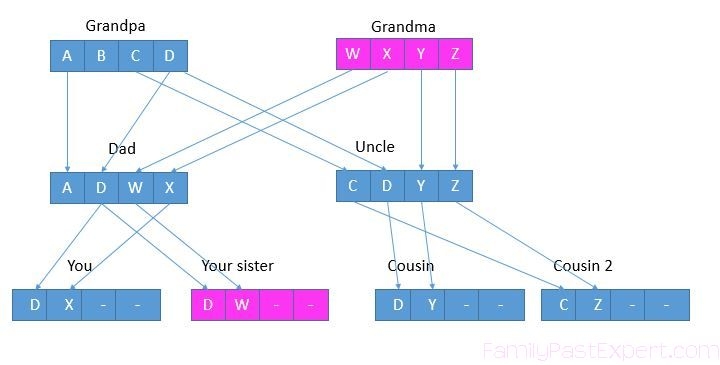
Your dad then passes down half of what he has to you and then does the same for your sister. Your mom gives you each two as well, but those aren’t shown in this example. Meanwhile, your uncle does the same for his kids. In this example, you, your sister and one of your cousins, all end up with a common piece “D” that originated with your grandpa. This continues down the generations, so through DNA testing, you may find distant cousins who share an element of DNA provided by a common ancestor.
The more you have in common, the more closely related you probably are. The tests can predict whether you are siblings, half-siblings, first cousins, sixth cousins, etc. with other people who have tested. With the combination of DNA results and old-fashioned family trees, you can work to figure out your common ancestor and how you are connected.
A Very Simple Y-DNA Example
If you are a male, then you have the same Y-DNA as your earliest paternal ancestor. Now, through the ages, mutations occurred to change things up, but we won’t get into that. At the most basic level, your Y-DNA is the same as your biological father’s and his is the same as his dad’s. Your paternal grandpa’s Y-DNA is the same as his dad’s and the same as yours (if you are a male). Girls are totally left out of the Y-DNA game. The following example is meant to show that the Y-DNA is passed down to the males in each subsequent generation. You will see that Great-Grandpa gave Grandpa his “Y” but didn’t give it to Grandpa’s sister. In this diagram, your male 3rd cousin and you will have the same Y-DNA because you are related through male ancestors. In other words, your 2nd Great-Grandpa gave both of his sons the same Y and they passed that same Y down to their male descendants. If you are a guy, this testing can be helpful in determining “who’s your daddy?” and a surname for your paternal line. Now, surnames changed over times sometimes too, like was often in the case of immigrants, but that too is another story.
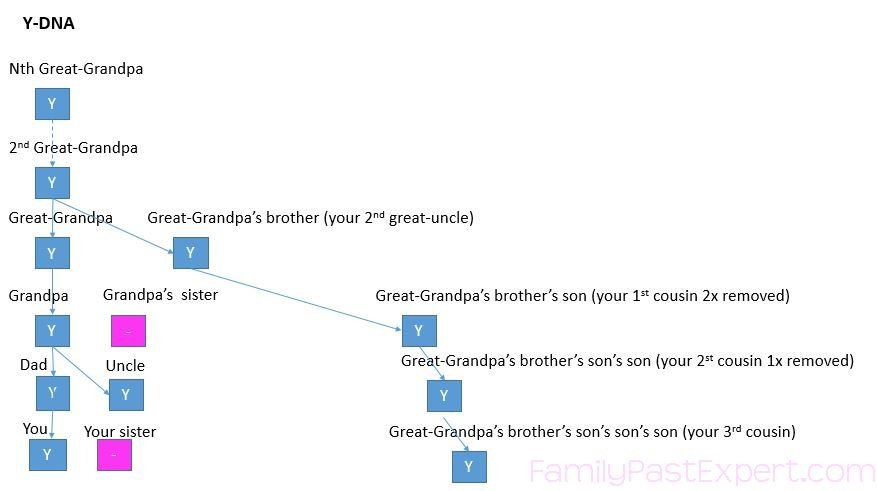
A Very Simple mtDNA Example
Everyone gets mtDNA from their mother. That mtDNA is the same as your earliest maternal ancestor. Again, we are ignoring mutations and how DNA changes over time. But, basically, whether you are gal or a guy, you and your mom have the same mtDNA and it is the same as your maternal grandmother’s mtDNA and so forth back through the generations. Males are too busy passing on their Y-DNA or something, so they don’t pass the mtDNA down to their kids. It stops with them. But, females pass the mtDNA down to both their sons and their daughters. In this example, you can see that your earliest maternal great-grandma passed down her mtDNA. Your 2nd great-grandma gave it to all of her kids, but only her daughters passed it down to their kids. Your grandma also gave it to all of her children. But, only your cousins from your aunt will have that shared mtDNA. Your uncle didn’t pass it to his kids. This testing can be helpful to determine your pure maternal line.
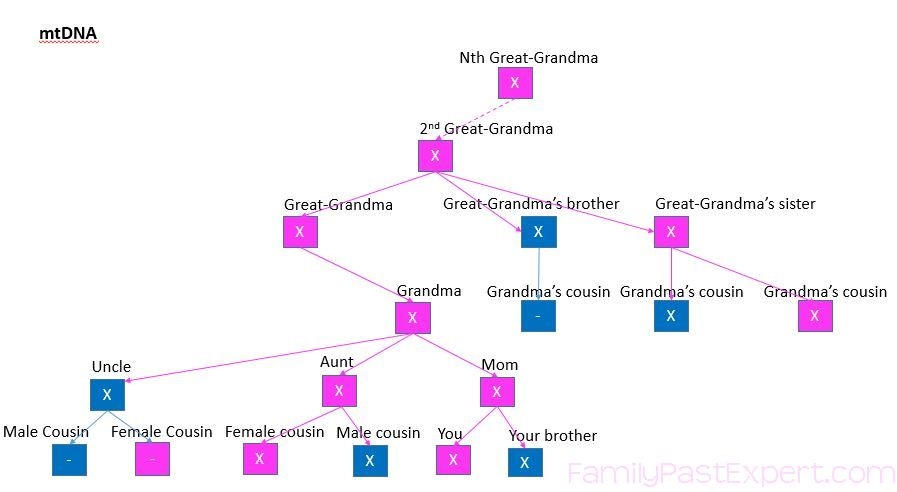
DNA Results
After you have spit in the test tube or swabbed your cheek (depending on which test you take), mailed in your sample, and waited and waited and waited for your DNA to be processed, you will not instantly see your complete family tree, but there is a lot you can do with the results.
Ethnicity
Many people just do the testing for the fun of getting an ethnicity estimate. Again, think about those ancestry commercials where someone finds out they are not what they thought they were.
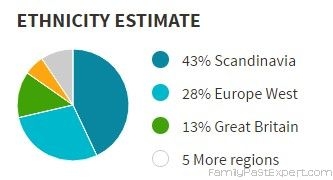
But that is just scraping the surface of what can be done.
Connecting with relatives and working your family tree
As a long-time family history buff, the most interesting part of DNA testing to me is being able to confirm that I have built my family tree correctly. When DNA results come back that show that Sally Smith is likely a 2nd cousin and my family tree lists Sally Smith as a 2nd cousin, that is a major victory.

But perhaps, even more fun, (yeah, I know that my definition of fun doesn’t always match what others think of fun) is when you can meet new cousins through DNA. Your results tell you that John Doe is likely a 3rd cousin, yet you’ve never heard of John Doe before. Working together, you trace back and figure out how you are related. Then you text or email and maybe even meet for coffee (or Diet Coke) and share photos and stories and information on your shared family tree. Very cool!

As more and more people do DNA testing and make their results available for comparison with others, the number of connections we can make to other family members will keep expanding. A disclaimer though… if you are looking for your cousin and she hasn’t taken a DNA test yet, you are not going to find her through DNA. And another disclaimer… you should be ready for surprises. Many genealogists who have worked decades on their family trees through old-fashioned paper-trail research, have had a surprise when they find that maybe grandpa’s father wasn’t really who great-grandma said he was.
Complex Analysis
You can also dig deeper. Sometimes it can be more complicated to figure out how you are related to your DNA matches. There are tools available to let you compare your results with someone at a very low level or triangulate to try to figure out how people are related. If you match with Sally Smith and John Doe, and John Doe also matches with Sally Smith, you may be able to figure out how John Doe fits into your tree. Most of you probably won’t get to this level of complexity, but when things get really complicated, there are people you can hire whose whole business is to unravel DNA genealogy for you.
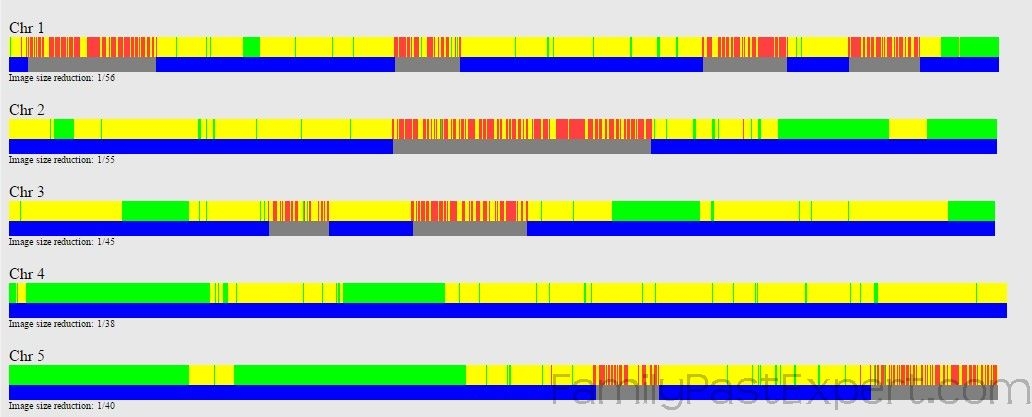
How can Family Past Expert help?
If you need some help… Family Past Expert can assist you in deciding which test to take and help you with a basic understanding of your results. I can also help you if you need help with the tools or with communicating with your DNA matches. And, as always, Family Past Expert can help you get started with your family tree and do research for you. Contact Family Past Expert today through email or purchase a services estimate to begin your family history journey.
Links to Education and Help Regarding DNA Testing
If you do a Google search, you can find tons of information on DNA testing. The following are a list of some that have been useful.
DNA for ‘Dummies’ — https://www.gedmatch.com/DNA_for_Dummies.php
Autosomal DNA Testing 101 – What Now? — https://dna-explained.com/2015/08/07/autosomal-dna-testing-101-what-now/
Autosomal DNA testing comparison chart — http://isogg.org/wiki/Autosomal_DNA_testing_comparison_chart
Y-DNA STR testing comparison chart — http://isogg.org/wiki/Y-DNA_testing_comparison_chart
MtDNA testing comparison chart — http://isogg.org/wiki/MtDNA_testing_comparison_chart
Most bang for the DNA buck — http://www.legalgenealogist.com/2015/02/02/2015-most-bang-for-the-dna-buck/ (written in 2015, so costs listed in the article may have changed.)
Sorting out the DNA Tests Available for Genealogy — http://genealogy.about.com/od/dna_genetics/a/dna-tests.htm
Proving Native American Ancestry Using DNA – https://dna-explained.com/2012/12/18/proving-native-american-ancestry-using-dna/
Why You May Be Reading Your DNA Results All Wrong – https://familyhistorydaily.com/genealogy-help-and-how-to/understanding-dna-results/
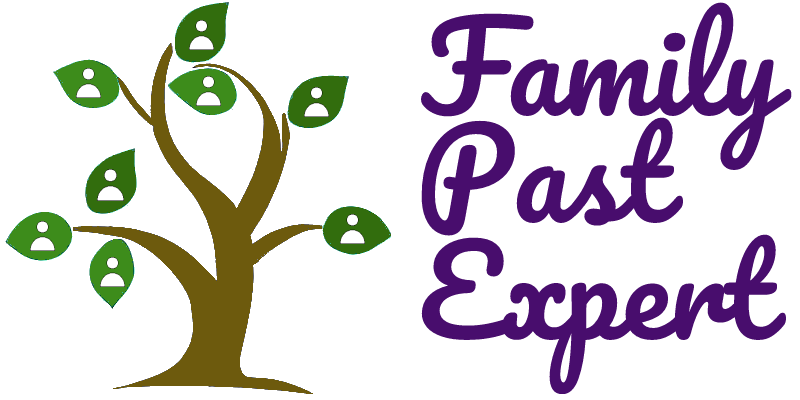

Leave a Reply